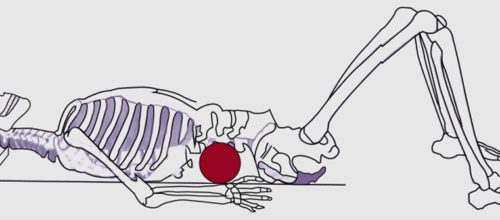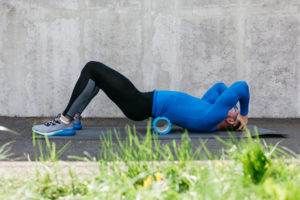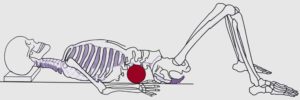
4 Reasons Why You Should Never Foam Roll the Low Back
Foam rolling is a self-massage technique that people use to relieve muscle tightness and improve range of motion. While foam rolling may have it’s benefit – the low back is one area that people should never foam roll, according to Dr. Stuart McGill.
Dr. McGill mentions on the strength students podcast that when one foam rolls the low back – they are applying full bodyweight shear stress to each vertebra, which could create painful micromovements in the low back.
While Dr. McGill shares some interesting information on foam rolling the low back – I can share an experience were foam rolling my low back triggered my symptoms.
When I was first dealing with low back pain from a herniated disc – I tried foam rolling my low back for pain relief. I would apply pressure into a foam roller and roll up and down my lumbar spine. On the first attempt, my low back felt good. But as I begun to adjust my lumbar spine position and apply pressure into the foam roller – the pain would arise. I wasn’t sure why this was at first, but I can remember the pain being sharp.
After this painful moment with the foam roller – I discontinued foam rolling the low back. And it wasn’t until I heard Dr. McGill mention “never foam roll the low back” did I start to study the effects foam rolling may have on the low back.
Now, I must state there hasn’t been any research to date studying the effects of foam rolling the low back. And the information against foam rolling the low back I’m about to share with you is from Dr. McGill’s opinion and my experience.
Why You Should Never Foam Roll the Low Back
1. Micromovements
To touch on Dr. McGill’s comments about foam rolling creating micromovements in the low back – you need understand that the outer portion of the spinal discs and facet joints contain pain receptors. People with instability in the low back from degenerative tissues may be prone to triggering a pain-response. Applying full bodyweight shear force to an unstable lumbar spine when foam rolling could cause painful micromovements.
The above video is an example of micromovements that may occur when foam rolling the low back.
People with asymptomatic or symptomatic abnormalities such as a disc herniation or facet joint osteoarthrosis would be at risk for making their abnormalities worse by foam rolling the low back. Asymptomatic people may become symptomatic. And symptomatic people may become worse.
2. Pressure Into the Low Back
For people with low back pain, foam rolling could trigger one’s symptoms by applying pressure into the foam roller from the low back. For example, someone with a lumbar disc herniation impinging on a nerve root could trigger their symptoms by foam rolling. The pressure from pushing the low back into the foam roller could cause the nerve to come into closer contact with a herniated disc.
How do I know this?
I’m guilty of doing this when I tried foam rolling my low back for pain relief.
3. Rolling Along the Low Back While the Spine is in Lumbar Extension
People with extension-based back pain (e.g., facet joint osteoarthrosis, spondylolysis, or spondylolisthesis) who move into lumbar extension and foam roll would be a concern – since they are recreating their pain trigger. Also, athletes who play a sport that is lumbar extension dominant – tend to have asymptomatic degenerative changes in their lumbar spine.
Consider the study by Rajeswaran et al., (2014) which found degenerative changes of the lumbar facet joints in 89% of elite tennis players. Also, Soler & Calderon, (2000) found the prevalence of spondylolysis to be 26.67% in elite throwing athletes. Foam rolling along a spine in lumbar extension with degenerative changes or a stress fracture is not a good idea. And many athletes have degenerative changes or a stress fracture without knowing it.
4. Lack of Support From the Rib Cage and Scapulae
When looking at the anatomy of the lumbar spine – it does not have the same support as the thoracic spine. The thoracic spine contains an attachment to the rib cage and scapulae which helps support the thoracic spine.
The lumbar spine does not have the same support system as the thoracic spine, and as a result – the lumbar spine will take more stress when rolling along it with a foam roller. Physical therapist Jeff Cavaliere does a great job of covering this topic in the video below:
Conclusion
Regular gym-goers, athletes and strength and conditioning professionals should be aware of the possible negative outcomes from foam rolling the low back – since many people tend to develop degenerative changes in the lumbar spine.
Degenerative changes in the lumbar spine create instability. And the application of full bodyweight shear to an unstable lumbar spine could trigger a pain response.
While foam rolling the low back may “feel” like it’s doing good for some – I would suggest one see a manual therapist if they need soft tissue work on the low back. Using the foam roller on the low back may only make an asymptomatic person symptomatic, or symptomatic person worse, which is not something we would want.
Cheers,
Remi
References
Rajeswaran, G., Turner, M., Gissane, C., & Healy, J. C. (2014). MRI findings in the lumbar spines of asymptomatic elite junior tennis players. Skeletal Radiology, 43(7), 925-32.
Soler, T., & Calderón, C. (2000). The prevalence of spondylolysis in the spanish elite athlete. The American Journal of Sports Medicine, 28(1), 57-62.













